[1] 吕雪雯,潘春玲.牙周组织工程的研究进展[J].中国医科大学学报, 2019,48(12):1132-1136.
[2] Caton J, Bostanci N, Remboutsika E, et al. Future dentistry: cell therapy meets tooth and periodontal repair and regeneration. J Cell Mol Med. 2011;15(5):1054-1065.
[3] PAN W, Wang Q, Chen Q. The cytokine network involved in the host immune response to periodontitis. Int J Oral Sci. 2019;11(3):30.
[4] Hu L, Liu Y, Wang S. Stem cell‐based tooth and periodontal regeneration. Oral Dis. 2018;24(5):696-705.
[5] Suzuki A, Horie T, Numabe Y. Investigation of molecular biomarker candidates for diagnosis and prognosis of chronic periodontitis by bioinformatics analysis of pooled microarray gene expression datasets in Gene Expression Omnibus (GEO). BMC Oral Health. 2019;19(1):52.
[6] 王宝华,赵亦非,沈莉蓉,等.牙周炎组织中miRNA表达谱差异筛选及功能预测分析[J].上海口腔医学,2019,28(4):408-411.
[7] 于世凤.口腔组织病理学:第七版[M].北京:人民卫生出版社,2019.
[8] Li S, Liu X, Li H, et al. Integrated analysis of long noncoding RNA-associated competing endogenous RNA network in periodontitis. J Periodontal Res. 2018;53(4):495-505.
[9] Wang J, Lu M, Qiu C, et al. TransmiR: a transcription factor-micro RNA regulation database. Nucleic Acids Res. 2010;38(Database issue): D119-D122.
[10] Hsu SD, Lin FM, Wu WY, et al. MiRTarBase: a database curates experimentally validated micro RNA-target interactions. Nucleic Acids Res. 2011;39(Database issue):D163-D169.
[11] Xiao F, Zuo Z, Cai G, et al. miRecords: an integrated resource for microRNA-target interactions. Nucleic Acids Res. 2009;37(Database issue):D105-D110.
[12] Sethupathy P, Corda B, Hatzigeorgiou AG. TarBase: a comprehensive database of experimentally supported animal microRNA targets. RNA. 2006;12(2):192-197.
[13] Jiang W, Zhang Y, Meng F, et al. Identification of active transcription factor and miRNA regulatory pathways in Alzheimer’s disease.Bioinformatics. 2013;29(20):2596-2602.
[14] Mariko K, Kataoka Y, Junya S, et al. Non-surgical model for alveolar bone regeneration by bone morphogenetic protein-2/7 gene therapy. J Periodontolol. 2018;1(18):85-92.
[15] Nedyalka V, Michelle E, Jacob M, et al. MicroRNA-1-mediated inhibition of cardiac fibroblast proliferation through targeting cyclin D2 and CDK6. Front Cardiovascular Med. 2019;6:65.
[16] Andisheh-Tadbir A, Javad Ashraf M, Jeiroodi N. Expression of CDK6 in Oral Squamous Cell Carcinomas. Asian Pac J Cancer Prev. 2018;19(4):1013-1016.
[17] Chen X, Zhang T, Shi J, et al. Noth1 signaling regulates the proliferation and self-renewal of human dental folliclecells by modulating the G1/S phase transition and telomerase activity. PLoS One. 2013;8(7):e69967.
[18] Kujan O, Huang G, Ravindran A, et al. CDK4, CDK6, cyclin D1 and Notch1 immunocytochemical expression of oral brush liquid‐based cytology for the diagnosis of oral leukoplakia and oral cancer. J Oral Pathol Med. 2019;48(7):566-573.
[19] Schiraldi C, Stellavato A, D’Agostino A, et al. Fighting for territories:time-lapse analysis of dental pulp and dental follicle stem cells in co-culture reveals specific migratory capabilities. Eur Cell Mater. 2012;24:426-440.
[20] Matthews BG, Roguljic H, Franceschetti T, et al. Gene-expression analysis of cementoblasts and osteoblasts. J Periodontal Res. 2016;51(3):304-312.
[21] Wu XL, Gu QH, Chen XP, et al. MiR-27a targets DKK2 and SFRP1 to promote reosseointegration in the regenerative treatment of peri-implantitis. J Bone Mineral Res. 2019;34(1):123-134.
[22] 池毓坦,许春姣,孙晓娟,等.分泌型卷曲相关蛋白1及β-连环蛋白在慢性牙周炎患者牙龈组织中的表达[J].华西口腔医学杂志, 2018,36(3).257-261.
[23] 杜锐,李隽,吴迎涛.SFRP1蛋白、MIF在重度牙周炎老年患者中的表达及与认知功能的相关性分析[J].上海口腔医学,2020,29(1):97-101.
[24] Anusuya GS, Kandasamy M, Jacob Raja SA, et al. Bone morphogenetie proteins: signaling periodontal bone regeneration and repair.J Pharm Bioallied Sci. 2016;8(Suppl 1):S39-S41.
[25] Ghuman MS, Maher A, Guilherme x, et al. Gingival fibroblasts prevent BMP-mediated osteoblastic differentiation. J Periodontal Res. 2019;54(3):300-309.
[26] Rao SM, Ugale GM, Warad SB. Bone morphogenetic proteins:periodontal regeneration. N Am J Med Sci. 2013;5(3):161-168.
[27] Liu WJ, Cui YJ, Wei JY, et al. Gap junction-mediated cell-to-cell communication in oral development and oral diseases: a concise review of research progress. Int J Oral Sci. 2020;12(1):17.
[28] 班桂飞,陈凤,欧永富,等.HtrA1、TGF-β1及Smad3在人牙髓细胞向成牙本质细胞分化过程中的动态表达研究[J].广西医科大学学报, 2017,34(5):676-680.
[29] Huang X, Liu F, Hou J, et al. Inflammation-induced overexpression of microRNA-223-3p regulates odontoblastic differentiation of human dental pulp stem cells by targeting SMAD3. Int Endod J. 2019;52(4): 491-503.
[30] Liu ZH, Guo L, Li RL, et al. Transforming growth factor-β1 and hypoxia inducible factor-1α synergistically inhibit the osteogenesis of periodontal ligament stem cells. Int immunopharmacol. 2019; 75:105834.
[31] Gu K, Fu Xh, Tian H, et al. TAZ promotes the proliferation and osteogenic differentiation of human periodontal ligament stem cells via the p-SMAD3. J Cell Biochem. 2020;121(2):1101-1113.
[32] Shi JW, Matthias F, Andrea W, et al. Differences in RUNX2 and P2RX7 gene expression between mono- and coculture of human periodontal ligament cells and human osteoblasts under compressive force application. Orthop Craniofa Res. 2019;22(3):168-176.
[33] Marconi GD, Diomede F, Pizzicannella J, et al. Enhanced VEGF/VEGF-R and RUNX2 expression in human periodontal ligament stem cells cultured on sandblasted/etched titanium disk. Front Cell Dev Biol. 2020;8:315.
[34] Lee M, Arikawa K, Nagahama F. Micromolar Levels of Sodium Fluoride Promote Osteoblast Differentiation Through Runx2 Signaling. Biol Trace Elem Res. 2017;178(2):283-291.
[35] Buhrmann Constanze, Bastian Popper, Aggarwal BB, et al. Evidence that TNF-β suppresses osteoblast differentiation of mesenchymal stem cells and resveratrol reverses it through modulation of NF-κB, Sirt1 and Runx2. Cell Tissue Res. 2020;381(3):83-98.
[36] Shaoqin Tu, Wu JY, Chen LL, et al. LncRNA CALB2 sponges miR-30b-3p to promote odontoblast differentiation of human dental pulp stem cells via up-regulating RUNX2.Cell Signal. 2020;73:109695.
[37] 逄键梁,邓天政,朱晓茹,等.c-Jun、c-Fos对人牙本质基质蛋白1基因转录调控作用的研究[J].现代口腔医学杂志,2010,24(6): 443-447 .
[38] 徐畅,魏亚红,王玉敏,等.Jun家族蛋白在釉质发育中的表达及对amelogenin的调控作用[J].牙体牙髓牙周病学,2015,25(9):515-528.
[39] Tang Y, Liu L, Wang P, et al. Periostin promotes migration and osteogenic differentiation of human periodontal ligament mesenchymal stem cells via the Jun amino-terminal kinases (JNK) pathway under inflammatory conditions. Cell Prolif. 2017;50(6):e12369.
[40] Nagayasu-Tanaka T, Anzai J, Takaki S, et al. Action Mechanism of Fibroblast Growth Factor-2 (FGF-2) in the Promotion of Periodontal Regeneration in Beagle Dogs. PLoS One. 2015;10(6):e0131870.
[41] Zhang FG, Song JG, Zhang HM, et al. Wnt and BMP Signaling Crosstalk in Regulating Dental Stem Cells: Implications in Dental Tissue Engineering. Genes Dis. 2016;3(4):263-276.
[42] Lu MT, Guo SY, Hong FL, et al. Pax2 is essential for proliferation and osteogenic differentiation of mouse mesenchymal stem cells via Runx2.Exp Cell Res. 2018;371(2):342-352. |
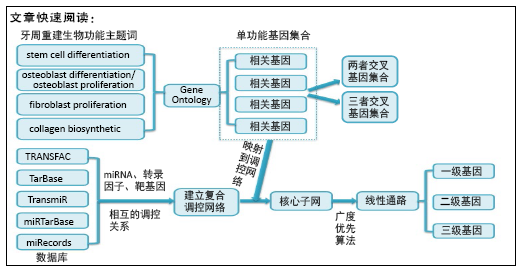
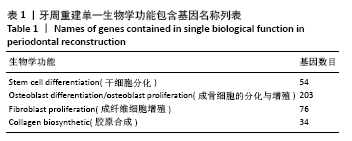
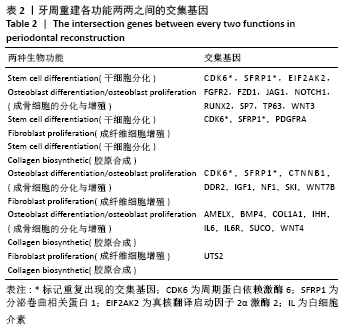
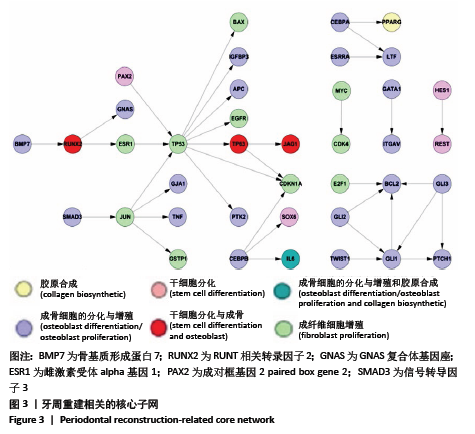
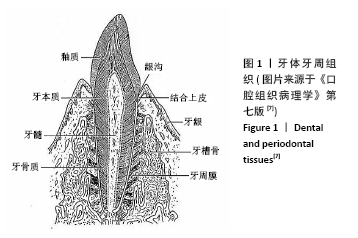
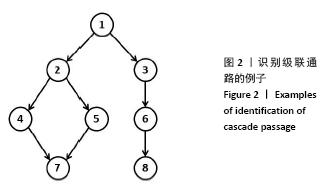
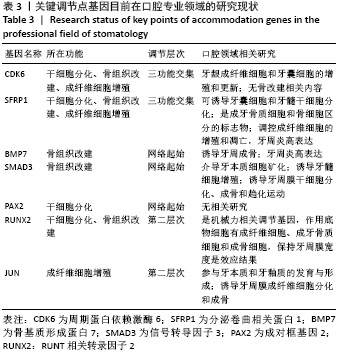 细胞周期依赖性激酶6(CDK6):迄今为止在口腔领域的相关研究只涉及牙龈成纤维细胞和牙囊细胞的增殖和更 新[15-16]。CDK6作为细胞周期依赖性激酶家族中的一员,它的主要功能在于:①决定细胞命运相关因素,如非对称定位和销毁时间;②结合调控细胞分化方向的信号;③保持有丝分裂区以保持干细胞的增殖能力[17-18]。截至目前关于CDK6和牙周组织的相关研究比较少,尚无学者研究CDK6和牙周重建的关系。
细胞周期依赖性激酶6(CDK6):迄今为止在口腔领域的相关研究只涉及牙龈成纤维细胞和牙囊细胞的增殖和更 新[15-16]。CDK6作为细胞周期依赖性激酶家族中的一员,它的主要功能在于:①决定细胞命运相关因素,如非对称定位和销毁时间;②结合调控细胞分化方向的信号;③保持有丝分裂区以保持干细胞的增殖能力[17-18]。截至目前关于CDK6和牙周组织的相关研究比较少,尚无学者研究CDK6和牙周重建的关系。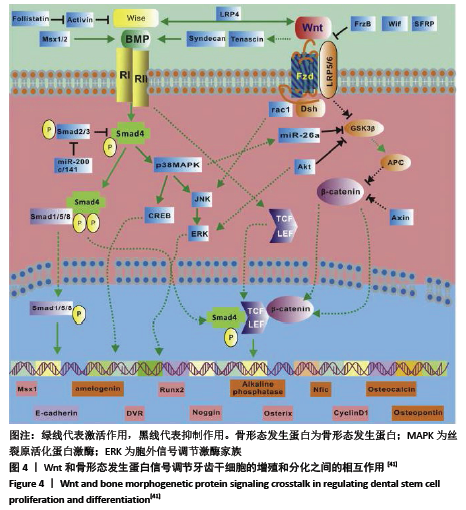 链状调控通路的每条通路都至少包括3种基因,而且近半数(15/34)通路所包含的基因都涉及3种生物功能,暗示其与牙周重建的整体过程密切相关。按不同生物功能归纳,链状调控通路包含成骨细胞分化/增殖功能相关基因共9个、成纤维细胞增殖功能相关基因共7个、干细胞分化功能相关基因共2个、干细胞分化和成骨交集基因共3个、成骨和胶原合成交集基因1个,不包含胶原合成功能相关基因。通过调控通路中包含各功能相关基因的数量可以看出,牙周重建过程中成骨和成纤维细胞增殖活动最活跃、最有意义,各自之间调节关系纷繁复杂。同时,在链状调控通路中无胶原合成功能调节作用,说明在牙周重建过程中胶原合成功能属非重要环节。
链状调控通路的每条通路都至少包括3种基因,而且近半数(15/34)通路所包含的基因都涉及3种生物功能,暗示其与牙周重建的整体过程密切相关。按不同生物功能归纳,链状调控通路包含成骨细胞分化/增殖功能相关基因共9个、成纤维细胞增殖功能相关基因共7个、干细胞分化功能相关基因共2个、干细胞分化和成骨交集基因共3个、成骨和胶原合成交集基因1个,不包含胶原合成功能相关基因。通过调控通路中包含各功能相关基因的数量可以看出,牙周重建过程中成骨和成纤维细胞增殖活动最活跃、最有意义,各自之间调节关系纷繁复杂。同时,在链状调控通路中无胶原合成功能调节作用,说明在牙周重建过程中胶原合成功能属非重要环节。